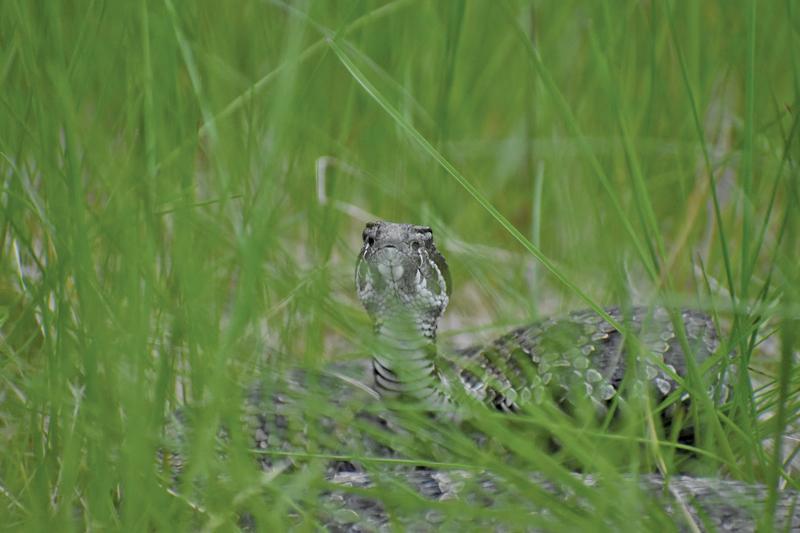Matthaei Botanical Gardens, where Parrish is natural areas manager, is home to a population of eastern massasauga rattlesnakes–about twenty-seven at last estimate. While many Ann Arborites are generally sympathetic to endangered species–as the EMR was designated in 2016–some are less than comfortable sharing space with a venomous snake.
Wetland drainage for agriculture and phobia-driven snake eradication are estimated to have eliminated half of the historic EMR populations in the Great Lakes Basin–the upper Midwest and parts of Ontario. In heavily farmed states like Illinois, says Grand Valley State University biologist Jennifer Moore, “there are only a handful of populations struggling to hang on.”
Lower Michigan has the largest number of populations: it’s the New York City of the massasauga. Daniel Kennedy, endangered species coordinator at the Michigan Department of Natural Resources (DNR) Wildlife Division, estimates that of 267 populations over the EMR’s ten-state-plus-Ontario range, 145 live in the Lower Peninsula.
Massasauga is an Ojibwa word meaning “great river mouth.” They are indeed tied to wet areas. These snakes need a habitat that pairs lower wetlands with drier uplands where they hunt their main prey: rodents, especially meadow voles–a lifestyle Washtenaw Community College zoologist David A. Wooten calls “bimodal.” Wooten has spent years working with snakes and the massasauga in particular. He says “they often hibernate in crayfish burrows and stay close to wetlands in the spring … emerging when the air temperature is warm enough.”
The EMR sits in the middle of nature’s energy transfers. It is predator and prey, and the snake’s removal harms that system. If someone kills a massasauga, they are killing a rodent-eating, blue-heron feeding node in this web. But humans tend to kill what seems threatening and to profit from what seems unique and powerful.
That’s why, when the U.S. Fish and Wildlife Service issued the order to list the species as threatened, it also “determined that the designation of critical habitat for the eastern massasauga rattlesnake is not prudent due to an increased risk of collection and persecution.”
Matthaei is in a unique position as a public space–it can’t keep the massasauga presence secret, but it can educate and enlighten the public and protect the snakes. Parrish says the Matthaei population has probably been in the same general area since the last glaciers receded, and one of his responsibilities is to maintain the landscape to make sure that it continues to work as it should for the snakes.
Because Matthaei is a popular spot, the massasauga and visitors occasionally encounter each other. In the past ten years, two people have been bitten–one adult and one child–both of whom were barefoot. The adult had left a path to walk in a field while looking up at a tree when she stepped on the snake, which then bit her ankle. The child was on a path approaching Willow Pond when a snake bit her ankle (it is unclear if she stepped on the snake). Both recovered after hospital treatment.
Michigan’s DNR describes EMRs as “shy creatures that will avoid humans whenever possible.” They move slowly and are not aggressive, striking only if they feel threatened. And because they have relatively short fangs, boots and jeans go a long way toward protecting visitors. Matthaei staff suggests wearing long pants and, if not boots, at least closed-toe shoes when hiking their paths (and staying on those paths). Keeping an eye on the ground and children close is also advised.
If visitors do encounter a snake, they should keep a safe distance and under no circumstances disturb it: “it’s dangerous, harmful to the snake, and it’s illegal,” says Jeff Plakke, general manager of landscapes at Matthaei. Because of its protected status, harming or killing one can result in fines and/or jail time.
People often misunderstand the snakes’ presence in the gardens and ask Parrish if they are trying to breed the rattlesnakes or if they will relocate them. “No,” he answers, “we’re trying to maintain a safe habitat so the snakes can survive on land they’ve populated for thousands of years.”




